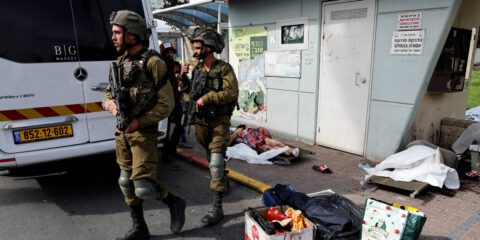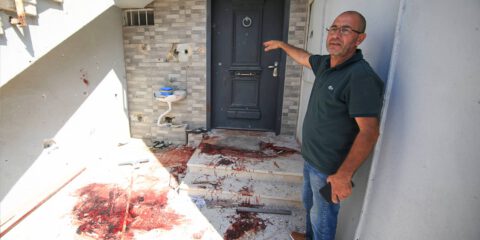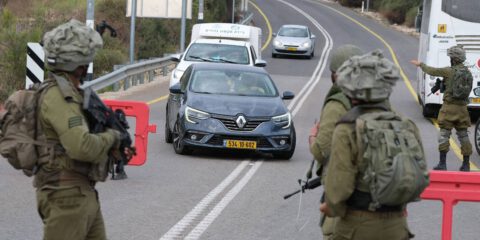It is necessary for Israel’s political and military leaders to readjust their conceptual framework concerning deterrence, and to engage the public in an open and effective dialogue on the deterrence equations. Also needed is a more specific and accurate capacity to strike fear into Hamas leadership by signaling both willingness and ability to destroy the assets that they value most.
Deterrence is a concept central to Israel’s defense doctrine. But when a second-rate terror organization, poor in resources, which also happens to be responsible for the survival and well-being of two million subjects in a crowded and vulnerable strip of land, is the one that spews forth threats to rain down rockets upon vital installations of a country many times stronger – the inevitable conclusion is that deterrence has been eroded and requires reformulation.
At the root of this is the paradox of Israel’s far superior power; its national order of priorities; and issues pertaining to legitimacy as a variable in the deterrence equation. Therefore, it is necessary for the political leadership and the IDF high command to readjust their conceptual framework, and to engage in an open and effective dialogue with the Israeli public (and the world) about deterrence equation in the present era – in which the power of symbols and images sometimes overwhelms common sense.
It would be wrong to be swept by the demands of some extreme elements within Israeli society for large numbers of casualties in Gaza. As demonstrated by the “March of Return” campaign (which began in March 2018), human lives are cheap to Hamas. However, what is necessary is a specific and accurate capacity to strike fear in the ranks of the organization, to threaten targets which Hamas highly values, and to threaten the survival of its senior command echelons as well as its very legitimacy in the eyes of a Gazan public eager for normal life.
Deterrence and the Paradox of Power
Deterrence has been central to Israel’s defense doctrine from its very inception. The doctrine is often ascribed to Ben Gurion’s speech to the Cabinet, before his retirement in October 1953 – even though the key words “Deterrence”, “Early Warning” and “Decisive Victory” (Harta’a, Hatra’a, Hachra’ah) were not used explicitly in the text. The purpose for Israel’s power – the overt component, and the elements about which Israel maintains deliberate ambiguity – is to convince any combination of hostile forces that it is pointless to try to forcibly destroy the State of Israel. The likelihood of success is slim, and the cost is likely to be intolerable.
This goal has indeed been largely achieved in the conventional realm for the better part of 50 years. True, the entry of Egypt’s army into Sinai in May 1967, the eruption of the “War of Attrition” shortly after the Arab defeat in the Six Day War, and the surprise attack on Yom Kippur in 1973 – all mark significant failures of deterrence. But in cumulative terms, Israel has been able to turn an overall military assault on Israel into an outdated idea. Even the massive use of force by an Arab state to achieve a more limited goal – as Sadat did in 1973 – is now quite unlikely.
At a JISS conference in October 2018 on the Iranian challenge, then-Defense Minister Avigdor Liberman mentioned that on a full war footing the IDF can muster 700,000 troops. This is a formidable force, which goes a long way towards explaining why Arab countries no longer plan frontal attacks on israel, and why some have crossed the Rubicon and signed peace treaties. However, the familiar deterrence model no longer applies regarding the option of harming Israel by other means, even if these do not threaten the country’s existence. Israel faces the “traditional” forms of terrorism like bombings and drive-by shootings, the firing of short-range and long-range rockets, as well as the more recent use of incendiary kites and booby-trapped balloons. These and the mass marches to the border fence are being employed against Israel despite Israel’s manifestly much greater military strength.
True, Hezbollah in Lebanon keeps the lid on violence along the frontier, even when Israel is acting against its tunnels; but this may reflect more than just the impact of Israeli deterrence. Side by side with the lessons learned from the losses Hezbollah sustained, and those suffered by Lebanon at large, during the war of 2006, Hasan Nasrallah has to take into account also the organizations’ entanglement in Syria, which is still far from over; as well as Iran’s quest to preserve Hezbollah’s full force and presence in the region as a deterrent against an Israeli (or American) use of force against its nuclear facilities.
Hamas has shown less restraint. The choices made by Hamas leadership may reflect intra-Palestinian or even intra-Hamas rivalries. But it would be wrong to describe them as driven by irrational urges. What they do indicate is an ability to detect a “crack in the rock” of the Israeli deterrence. This is effectively used so that calculated and controlled dosages of use of force serve to elicit from Israel key concessions on issues of direct importance for Hamas. This is particularly relevant in the economic arena, which carries with it symbolic and moral significance (“lifting the siege”). This is a mode of action with a high price tag in human lives on the Palestinian side – specifically in the “marches of return” – but is nevertheless perceived as worthwhile. On the Israeli side, material and psychological damage has been inflicted by the incendiary kites and balloons, including massive damage to protected nature reserves. But this has not led (so far) to significant casualties.
Hamas’ choices are thus intended to feed Israeli current dilemmas about deterrence. Even the extensive firing of rockets after the incident in Khan Yunis was managed by Hamas in a manner designed to leave it, not the IDF, in control of the so-called escalation ladder.
What has Undermined Israeli Deterrence?
How did this erosion of deterrence come about? In Israeli public discourse, claims have been gaining ground attributing this to a weakening of willpower, fatigue and folly, even “cowardice” at high places; and to excessive legal constraints which have presumably “paralyzed” the IDF and led its officers to err on the side of over-caution.
While it is appropriate to conduct a proper professional debate on the question of the offensive versus the defensive spirit in the IDF, and the renewed quest of a “decisive outcome” (hachra’ah) – it is both wrong and dangerous to attribute fear to the IDF high command. The mere accusations are harmful to deterrence, insofar as they are picked up by the sensitive ears of the other side. Moreover, it makes it almost impossible to conduct an intelligent discussion as to the components of an effective response to the complex challenge that the Hamas leadership has managed to pose.
A more penetrating analysis of the present state of the deterrence equation brings up a combination among four factors. The first, and most paradoxical, has to do with the extreme discrepancy in power. On the face of it, this an absurdity; the basic deterrence equation is supposed to reflect the relative capacity of each side harm the other. In this aspect, Hamas provocations in face of the IDF firepower, and particularly its air force, can be interpreted as irrational. It is reminiscent of a child entering the lion’s den in order to find out what would happen if he sticks it with a knitting needle. In practice, however, the history of confrontations between powers and forces much weaker than them is replete with evidence that it is not the arithmetic of relative destruction which counts, but the question of the strategic purpose.
Had the Johnson Administration been willing to invade North Vietnam and conquer it, it would have been possible to establish effective deterrence towards the Hanoi regime; but since the U.S., scarred by the Korean experience more than a decade earlier, ruled out that option, the immense fire power the US brought to bear, and the massive bombings of the North’s urban centers, could not in themselves turn into an effective deterrent equation.
Similarly, the Hamas leadership knows that Israel does not wish to retake Gaza. The reasons for this have less to do with the losses expected during such a campaign, but rather with the reluctance to get mired there for years, and constantly bled “the day after”. This realization greatly reduces the effectiveness of Israel’s deterrent messages. Moreover, precisely because Hamas is so relatively weak, there is no urgency in the IDF high command to destroy Hamas, or to deprive it of its capabilities. Delay to a later, more convenient time is always possible. In addition, the ongoing political division within the Palestinian national movement between Hamas and the PA weakens the Palestinian side and enables Israel to portray Hamas as part of the Islamist camp threatening regional stability.
This component is interwoven with the broader issue of priorities. True, the IDF can in fact fight a high-intensity war on two fronts, south and north. But why should it let run the risk that it might happen, given that an entanglement in Gaza would reduce Israel’s deterrent posture towards Hezbollah and Iran and when the Iranian threat, and the capabilities of Hezbollah, are far more significant than anything Hamas can do? The logic of avoiding an escalation in Gaza thus seems conclusive, certainly at a time in which tensions with Iran are rising due to the latter’s possible response to the tightening sanctions, and when Israel feels obliged to act to deny Hezbollah the capacity to penetrate Israeli territory through tunnels. Still, when explicit messages from the Israeli leadership consistently places the threat in the north as the top national security priority, Hamas inevitably reads this as a sign that they are safe from all-out action. It should come as no surprise, therefore, that the leadership in Gaza is increasingly willing to take risks, knowing that Israel will be reluctant to go up the escalation ladder.
Setting priorities is linked to the third factor – the desire to avoid expanding the conflict deeper into Israel. Hamas openly exploits this Israeli preference: “if the fighting continues, we shall strike Beersheba and Ashdod, and then – Tel Aviv”. Minister Tsachi Hanegbi, to the dismay of many, confirmed that government policy reflects the preference for keeping the Tel Aviv area (Gush Dan), where the bulk of Israel’s economic activity takes place, out of the orbit of rocket fire. This is a morally sensitive issue, since the regularly-targeted areas feel justifiably aggrieved; and because Hamas’ posture amounts to blackmail through the threat of extended violence. In practice, however, this does present a weak spot in Israeli security policy, which perhaps should not have been brought up in public. As a small country, in a world where business interests can migrate almost instantly, studiously avoiding tensions and violence, Israel’s cold-blooded calculations are understandable. But the public discourse serves to weaken deterrence even further.
A fourth dilemma, equally complex and morally challenging, has to do with acquiring legitimacy for IDF’s operations. Punitive actions in Gaza, which would result in extensive casualties, can presumably help restore deterrence by re-establishing a new “balance of terror.” But a closer look reveals that due to the collateral damage such actions could be counterproductive for Israel’s standing in the international arena. It is possible to discern deliberate efforts to draw Israel into responding by attacks on Hamas targets located within civilian compounds. As Hamas is ready to spill the blood of their own people, such strikes do not necessarily enhance deterrence.
Israel is less concerned by issue of the “legality” of its military actions or by the threat that officers and officials, or even political leaders, would be indicted by the ICC in the Hague (although these can have unpleasant implications) than by the prospect of serious harm to critical national interests. Israel must consider a question mark over its access to key markets, particularly in Europe. For an export-oriented nation (whose exports in 2017 crossed the $100 billion mark), this is not a negligible consideration. For Hamas, as well as for Hezbollah, this is a clearly-identified Israeli weakness, and they deliberately seek to confront Israel with the dilemmas of fighting in densely populated areas. Thus, the great caution taken to avoid collateral loss of life, including the widely-used “knock on the roof” procedure (which alerts residents of a building that it is about to be bombed) is not a sign of Hamas intimidation, or of unfair legal interference, but rather a demonstration of the IDF’s professionalism and of its ability to adjust to specific missions and to ever-changing circumstances.
Restoring Deterrence
Considering the factors discussed above, it is important to present a creative, asymmetrical response that does not involve “fighting the enemy by its own methods.” (Winston Churchill reportedly asked an MP who advocated mirroring the enemy’s ways whether the honorable gentleman had ever tried to step on an elephant or sting a mosquito).
Israel need not be drawn by Hamas into a campaign the latter seeks, nor should the IDF become a contractor for PA President Mahmoud Abbas in his quest to rid himself of political enemies. The operational guidance of the IDF in 2014 is still essentially valid. The purpose of military action, should it again become necessary, needs to be “Hamas weakened and deterred.” Only a body with its head still on its shoulders can be deterred, since the effect of deterrence requires a capacity to take decisions and to implement them. The present leaders of Hamas have already given proof, in word and in action, of their ability to choose their options wisely, in terms of their own purposes. It now falls to Israel to draw for them a “road map” which would help them understand that the continuation of the struggle has become pointless, and its price would go ever higher if the violence resumes.
The reasonable (yet not certain) working assumption is that despite all that has happened, there is still a prospect of demonstrating to the Hamas leadership that a deep chasm separates their bravado and their threatening language, and the real balance of power. If some Hamas leaders have been able to persuade themselves that they have “won” the last round, there are ways of impressing upon them, through channels they will regard as reliable – and without exposing any sensitive material – just how extensive were the options that the IDF was weighing at the time, and what the Israeli operational logic may be next time.
This would serve to indicate that Israel had not been “deterred” by their threats, but rather chose restraint for its own reasons. Procedures such as “knock on the roof” and the caution taken to avoid extensive loss of life should be shown to have been deliberate decisions, professionally and systemically carried out, due to Israel’s present priorities, and not a reflection of Hamas’ purported “escalation dominance.” Moreover, a different decision may be taken the next time.
Egypt’s channels of communication with Hamas (and PIJ) can play a useful role in imparting such messages. It would sound more persuasive coming as an objective assessment from a third party as to what Israel can and might do. A direct threat also has the drawback of binding Israel’s hands, and reducing the scope for flexible responses when the moment comes. It is thus important to use Israel’s own discussions with the Egyptians to convey clear messages to this effect. There can be no certainty as to the success of such efforts to restore deterrence, which is indeed a tricky concept, and one whose effectiveness is hard to measure. In the absence of a systemic effort to restore deterrence, the periods between major rounds of violence may get shorter and shorter, which is very much against Israel’s interests.
Alongside the Egyptian channel, the IDF’s highly developed psy-op units should be mobilized at this time to sharpen the message – as was already done, to some extent, in the media coverage of the recent exercise of the Commando Brigade. Paradoxically, even the ongoing echoes of the Khan Yunis clash can be used to deepen the alarm in the ranks of Hamas as to the ability of Israel to use special forces deep within Gaza, in addition to the air and ground capabilities they are familiar with. The jihadi organizations should be made aware that Israel will not hesitate to use such options, if necessary, to exact higher costs for Hamas. This set of costs should include sensitive assets of Hamas (and PIJ) as well as degrading their symbols and their self-image.
In addition to the destruction of significant material assets that the Palestinian side has to some extent grown used to, it is important to make them aware of the prospect of precise targeted attacks on the mid-level command ranks of Hamas and PIJ. The purpose would be to mark for elimination ranks senior enough to disrupt the command structure and reduce the effectiveness of their fighting forces, and to generate greater fear among the higher echelons. A latent threat of destruction should hang over the heads of Hamas leaders. Yet, it is preferable not to come to the point of “decapitating” the high command, to preserve the Hamas ability to take decisions to restore calm.
Another aspect, which relevant only in the case of a severe escalation, must include the option of capturing Hamas fighters and commanders alive, through commando raids. The full implication of such operations derives from the pretense of the “jihadi” forces to prefer a “martyr’s death”, in battle or in terror attacks, over surrender. Hence, the supreme importance of using such “assets” to Israel’s long-term national interest, in this era of images and symbols, for bargaining for the bodies of two IDF soldiers and the release of the Israeli citizens held in Gaza and for undermining the “legend of the Muqawama” (resistance). The awareness that this might indeed happen may help persuade Hamas’ leadership that they should avoid any provocation which could trigger such IDF aggressive and creative operational methods.
Such warnings need to be backed up by the actual review of the conceptual frameworks and of military planning, in the relevant military levels and among other security agencies. The changes in command at the IDF and Southern Command helm provide a proper opportunity for rethinking. A good balance should be struck between continuity and new ideas, to adopt a more offensive approach.
A complementary dimension in enhancing deterrence beyond willingness and legitimacy to use greater force in the next round is in the diplomatic arena. The more Israel establishes a firm diplomatic and strategic position in the world, and in the Arab and Muslim world, the less likely the Palestinians would be to succeed in their strategy of isolating and boycotting Israel. Displays of diplomatic prowess, from Oman to Chad and from the Philippines to Argentine, contribute to undermining the enemy’s logic. This is particularly true for the PA, for which isolating Israel has been a central policy pillar; but for Hamas too, which in recent years made efforts to woo European sympathies.
JISS Policy Papers are published through the generosity of the Greg Rosshandler Family.
photo: Bigstock








 - בניית אתרים
- בניית אתרים